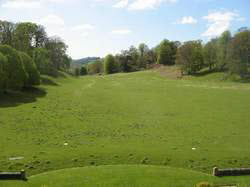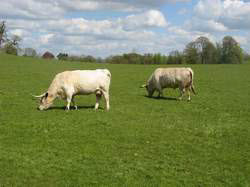Abandoned Communities ..... Tywi Valley
In 1400 the national uprising led by Owain Glyndwr began. Glyndwr entered the Tywi valley in the summer of 1403. He received the surrender of Dryslwyn castle on 4 July, but Dinefwr under the constable John Havard successfully resisted a ten day siege. Letters from Havard to his friend John Fairford of Brecon provide a vivid impression of the siege and the emotions of those inside the castle. Dinefwr seems to have remained in English hands until the uprising of Glyndwr came to an end around 1408.
The rebellion of Owain Glyndwr was the last occasion on which any real threat to English domination of Wales was mounted. Almost six hundred years would pass before power again began to be devolved to the people of Wales. The military significance of Dinefwr and Dryslwyn soon declined. Dryslwyn castle may not have been occupied again. It is likely that people living in the township below it gradually moved away. Those who had property in the surrounding agricultural land may have built a home on their property or close to it. Some of them may have taken advantage of the low price of land at the time to acquire more land. Those whose livelihood came from providing services to the castle would have had to move elsewhere to continue their trade.
At Dinefwr the castle continued to be occupied for another century or so. The living quarters were improved, but its defensive features were not maintained. Rents from both the original town and Newton fell during the fifteenth century, an indication that people gradually moved away. Around 1532 the owner of the Dinefwr estate built a substantial new home “within the town of Newtone”. A lot of houses must have been demolished in the process. Part of the estate was converted into a deer park, and other areas were enclosed for sheep and cattle. A few years later, in 1539, John Leland travelled through south Wales and recorded that at Dinefwr there was “sumtime a long streat nowe ruinus”. The maintenance of a small town did not feature in the estate owner's development plans. The castle continued to be used as a venue for picnics, and in due course a summerhouse was erected on top of the castle keep.
Today Dinefwr castle is maintained by Cadw, the organisation with responsibility to protect the built heritage of Wales. The present Newton House is on the same site as the house built in the 1530s. It is managed by the National Trust.
There is a short section on Newton House in Simon Jenkins' book Wales: Churches, Houses, Castles, Allen Lane 2008. Simon Jenkins praises the restoration of the building but was “less persuaded by the appearance of actors in the rooms”. A little too generously he has awarded three stars to the house.
A lot of splendid photographs of Dinefwr and Dryslwyn castles can be found on the Castles of Wales website.
The rebellion of Owain Glyndwr was the last occasion on which any real threat to English domination of Wales was mounted. Almost six hundred years would pass before power again began to be devolved to the people of Wales. The military significance of Dinefwr and Dryslwyn soon declined. Dryslwyn castle may not have been occupied again. It is likely that people living in the township below it gradually moved away. Those who had property in the surrounding agricultural land may have built a home on their property or close to it. Some of them may have taken advantage of the low price of land at the time to acquire more land. Those whose livelihood came from providing services to the castle would have had to move elsewhere to continue their trade.
At Dinefwr the castle continued to be occupied for another century or so. The living quarters were improved, but its defensive features were not maintained. Rents from both the original town and Newton fell during the fifteenth century, an indication that people gradually moved away. Around 1532 the owner of the Dinefwr estate built a substantial new home “within the town of Newtone”. A lot of houses must have been demolished in the process. Part of the estate was converted into a deer park, and other areas were enclosed for sheep and cattle. A few years later, in 1539, John Leland travelled through south Wales and recorded that at Dinefwr there was “sumtime a long streat nowe ruinus”. The maintenance of a small town did not feature in the estate owner's development plans. The castle continued to be used as a venue for picnics, and in due course a summerhouse was erected on top of the castle keep.
Today Dinefwr castle is maintained by Cadw, the organisation with responsibility to protect the built heritage of Wales. The present Newton House is on the same site as the house built in the 1530s. It is managed by the National Trust.
There is a short section on Newton House in Simon Jenkins' book Wales: Churches, Houses, Castles, Allen Lane 2008. Simon Jenkins praises the restoration of the building but was “less persuaded by the appearance of actors in the rooms”. A little too generously he has awarded three stars to the house.
A lot of splendid photographs of Dinefwr and Dryslwyn castles can be found on the Castles of Wales website.
Five
Parkland on the west side of Newton House, where part of the town of Newton would have been.
Parkland to the east of Newton House. This breed of white cattle have been reared at Dinefwr since the Middle Ages.

